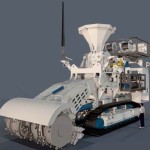Newsweek broaches this subject discussing the move by China to being exploring the mining of massive sulfide deposits, i.e. hydrothermal vents. Samantha Smith from Nautilus, another company exploring mining in PNG states “We’ve put in place a number of measures to ensure that ecosystems and biodiversity are maintained.” But I am one unconvinced much as I was nearly 3 years ago when I wrote my first deep-sea mining post. Deep-sea mining continues to be on our radar and it should be on yours to. Why am I skeptical?
- Seafloor mining would create sediment plumes that would smother organisms relying on filter feeding.
- Removal of hydrothermal vents, even extinct, could potential expose non-vent organisms to toxic levels of heavy metals. These species, unlike those occurring at vents, are not adapted for this exposure.
- Mining operations are not delicate processes and as such unintentional destruction of nearby habitats is likely. In my experience with one ton plus, remote operated vehicles precisions movements are often not possible.
- The economic incentive lies with continued and total removal of vent fields not with their protection. Will mining companies exercise discretion. Lessons from terrestrial mining indicate they will not.
Prior DSN posts about mining the seafloor
- NIOT will starts the next phase of fields trials at 1000m for deep-sea mining equipment
- Vents of gold
- Deep-sea mining workshop at Woods Hole
- A brief pardon for PNG deep
- Nautilus invests more money in mining
- Legislative reform needed to protect ocean floor from mining
- Nautilus moves to new phase (courtesy of Rick Macpherson)
- Everything you wanted to know about Nautilus Mining
- The new ‘gold rush’ off Africa
- Is PNG for sale? Tribal villagers think so.
- How mining the ocean floor is good not bad
- DSN’s first post on deep-sea mining from 2007





